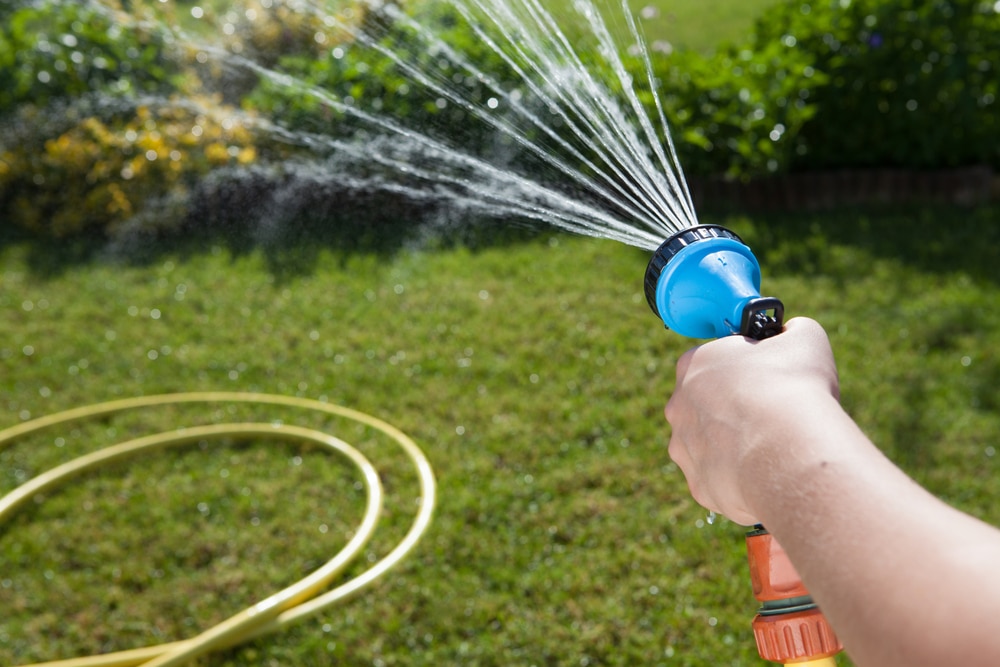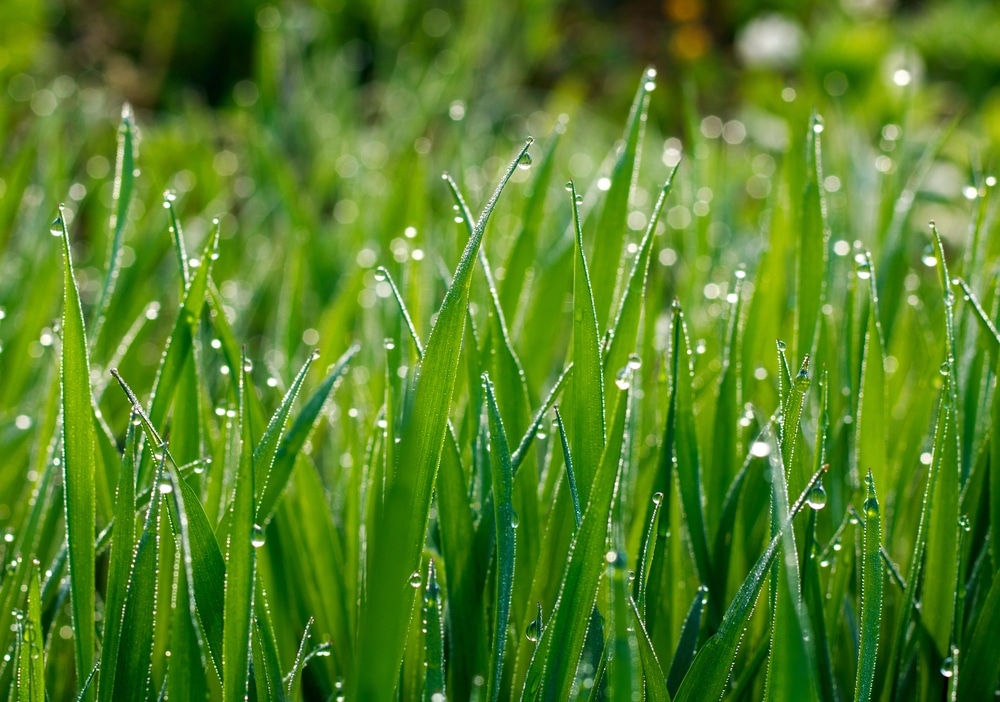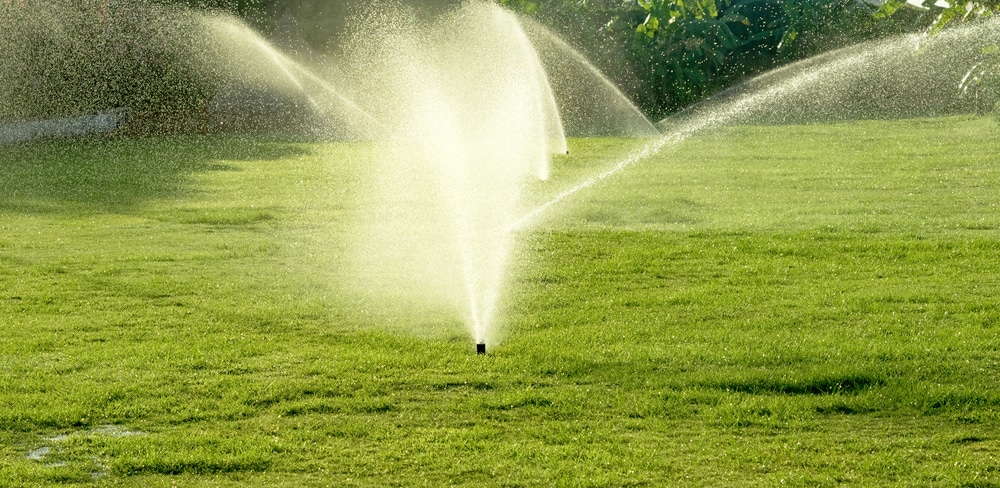It is a common misconception that as long as you water your lawn, it will thrive. This is only true in its most basic sense: You do have to make sure your lawn gets the moisture it needs. But there are several steps to take to do it correctly.
Remember, your lawn is alive. The soil needs a proper environment to deliver the right nutrients to the roots. Water is an important part of this. It plays an important role regardless of whether it is coming by way of condensation or through your sprinkler system. How long you water your lawn, how often you do it, and when you do it are all important.
Keep reading for all of the factors you need to consider before heading outside and turning on the spigot.
In addition to giving your grass enough water, you also need to make sure your are mowing it. Learn what to do if your lawn mower does not start here on the Green Pinky.

Different Types of Delivery Systems
Not all irrigation systems are created equally. Below is a basic explanation of the primary ways of taking care of your property.
In-Ground or Pop-Up Irrigation System
- The most consistent way to provide your garden with the moisture it needs
- Turns on at preset times
- Delivers a precise amount before automatically shutting off
Oscillating Sprinkler System
- Sprays vertically and moves back and forth over a specific area of your yard
- Susceptible to both interference from the wind and evaporation
Pulsating or Rotating Sprinkler System
- Sprays out horizontally at a high velocity
- Less susceptible to wind interference and evaporation
- Preferable to oscillating sprinklers

Watering by Hand
- Use of sprayer attachments on the garden hose for different types of coverage
- Beneficial in that you can physically see how much liquid you are distributing over each area
How Often Should You Water
How frequently you water your property depends on a few different factors.
The first consideration is the type of grass you grow. Generally speaking, cool-season grasses, such as Kentucky bluegrass or perennial ryegrass, are thirstier than warm-season grasses like St. Augustine or Bermuda grass. A good rule of thumb is to soak cool-season grasses every two to three days and warm-season grasses every three to four days during the growing season.
Newly seeded lawns require more attention, unless there is sufficient rainfall to keep the soil moist. Be careful not to flood the soil, as this will wash away the grass seed before it has the chance to take root.

In the colder parts of the year, your yard’s need for nourishment is entirely dependent on the type of winter weather you experience. In the parts of the country where snow and frost are a constant, you can hang up the irrigation equipment until the thaw of spring.
In milder climates, where freezing temperatures are interrupted by the occasional warmer day, the sporadic precipitation should provide a sufficient amount of moisture to sustain your lawn.
How do you know if your lawn needs a good soaking during the winter months? Remember this phrase: “If you’re still mowing, your lawn is growing.” If this is true for your lawn, it needs to be cared for according to the schedule mentioned above until it stops growing.
How Long Should You Leave It Running
Your lawn needs between 1 and 1.5 inches of moisture per week to maintain ideal soil conditions. That means you need to really soak the ground. But you do not need to do this every day. Generally speaking, watering your lawn for 20 minutes to 30 minutes, three times per week, fulfills the soil’s needs. There are a couple of ways to ascertain the amount of liquid your grass is getting every time to hook up the hose or turn on the sprinkler.
Flow or Water Timer
Timers measure flow in the total number of gallons of liquid your lawn is receiving. The formula for determining how many gallons you need to provide your lawn with one inch of water is a relatively simple calculation. Take the total square footage of your property and multiply it by 0.62 gallons. The number you get will give you the total number of gallons needed to cover the area with one inch of liquid.
If you are soaking your lawn more than once a week, divide that number of gallons by the number of days you plan to use the sprinkler or hose, and you will have the correct number of gallons for each time you plan to provide for your grass. Program your timer to shut off at the desired number of gallons, and you’re done.
Timers are ideal for in-ground irrigation systems.

Tuna Can Method
Measure the depth of moisture each area of your land is receiving by placing an empty tuna can flat onto the ground in the area you will be watering. All you have to do is water your lawn until the liquid rises to a specified depth in the tuna can. The number of days you plan on using a sprinkler or hose will determine the necessary height of fluid in the tuna can.
The corresponding depths are:
- Every four days: ½” to ¾”
- Every three days: ⅓” to ½”
- Every two days: ¼” to ⅜”
Once you have determined how long it takes to fill the tuna can to the desired height, you can set your sprinkler timer to always stay on for that amount of time. This way, you ensure that your garden receives exactly what it needs.
Screwdriver Method
Another way to tell if your soil is wet enough on average is to take a standard screwdriver and push it into the soil. If you can push it down to the handle, then you are using the correct amount of water.

Best Time of Day
The best time for the grass to be watered is between the early morning and 10 a.m. This will keep the earth cooler during the hottest parts of the day and allow ample time for the grass to dry before nightfall.
If this is not practical, late afternoon is also an acceptable time to perform lawn care. Because the sun is still out, liquid still has time to evaporate from the blades and absorb into the soil. However, watering this late in the day should be avoided, if possible.
Avoid watering in the evening entirely. If your lawn is wet once the sun has gone down, it will be damp throughout the night and thus more prone to disease and fungus growth.
Effects of Under Watering
An insufficient amount of moisture will cause the soil to dry out and your lawn to discolor.
Lack of moisture can lead to the appearance of the heat and stress fungus ascochyta leaf blight (also called the dollar spot fungus). This fungus is characterized by a yellowing in the middle of the grass blades.
When the soil becomes too dry, beneficial microbial activity decreases significantly. The microbes that provide nutrients to plant and grass roots need moisture to sustain themselves.
Often, grass will go dormant if it does not receive enough liquid. This can quickly happen when you neglect your yard during a drought or hot summer months. When grass goes dormant, it begins to discolor and ceases to grow.

Effects of Over Watering
If you overuse your hose or sprinkler system, your grass’ root system can drown because it no longer receives the air it needs to survive. Porous soil has pockets of air that aid in the circulation of the oxygen and nutrients vital for the growth and strength of the roots.
Newly established lawns need a chance to dry, otherwise grass roots stay shallow because they do not have to grow deep into the ground to find a water source. Shallow roots make for grass that is not as viable and more prone to disease and fungus growth.
Furthermore, constantly damp lawns will result in an excessive amount of weed, like crabgrass or nutsedge. Patches of thick thatch will appear in different areas of your property. There will also be more insect activity on wet grass, because bugs use it as a water source.

Over-watering will increase your grass’ need of fertilizer. The excess moisture will push the fertilizer quickly through the grass’ root zone. Once it has gone beyond the root system, ground pollution occurs in the form of nitrogen run-off.
Last, but not least, you will see an unnecessary increase in your energy bill. Running your sprinkler system for long periods of time delivers more moisture than your grass needs and uses up unnecessary electricity, with no positive result.
So, make sure you know how often and for how long you need to water your grass. With these tips, you will have luscious and healthy grass in no time.
–The Green Pinky

